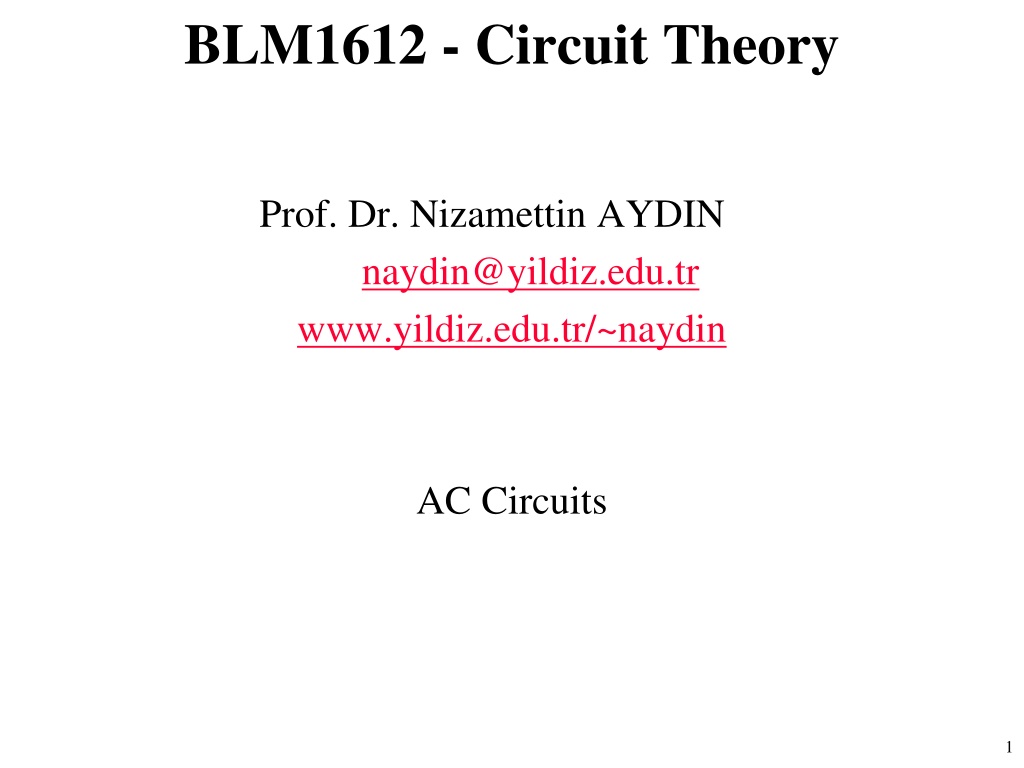
Impedance and Ohm's Law in AC Circuits
Explore the mathematical relationships between AC voltage and current in resistors, capacitors, and inductors. Learn about phase relationships and adaptations of Ohm's Law for capacitors and inductors. Derive formulas for impedance and admittance of components for AC circuits.
Download Presentation

Please find below an Image/Link to download the presentation.
The content on the website is provided AS IS for your information and personal use only. It may not be sold, licensed, or shared on other websites without obtaining consent from the author. If you encounter any issues during the download, it is possible that the publisher has removed the file from their server.
You are allowed to download the files provided on this website for personal or commercial use, subject to the condition that they are used lawfully. All files are the property of their respective owners.
The content on the website is provided AS IS for your information and personal use only. It may not be sold, licensed, or shared on other websites without obtaining consent from the author.
E N D
Presentation Transcript
BLM1612 - Circuit Theory Prof. Dr. Nizamettin AYDIN naydin@yildiz.edu.tr www.yildiz.edu.tr/~naydin AC Circuits 1
Impedance and Ohms Law Objective of Lecture Describe the mathematical relationships between ac voltage and ac current for a resistor, capacitor, and inductor . Discuss the phase relationship between the ac voltage and current. Explain how Ohm s Law can be adapted for inductors and capacitors when an ac signal is applied to the components. Derive the mathematical formulas for the impedance and admittance of a resistor, inductor, and capacitor. 2
Resistors Ohm s Law v(t) = Ri(t) = R Imcos( t + ) V = RIm = RI where = The voltage and current through a resistor are in phase as there is no change in the phase angle between them. 3
Capacitors i(t) = C dv(t)/dt where v(t) = Vmcos( t) i(t) = -C Vmsin( t) i(t) = CVmsin( t + ) i(t) = CVmcos( t + - ) i(t) = CVmcos( t + ) 4
Capacitors V = Vm I = CVmcos( t + ) Vmcos( t + ) = V ej = V = jV I = j CV or V = (1/j C) I = - (j/ C) I 5
Capacitors 90ophase difference between the voltage and current through a capacitor. Current needs to flow first to place charge on the electrodes of a capacitor, which then induce a voltage across the capacitor Current leads the voltage (or the voltage lags the current) in a capacitor. 6
Inductors v(t) = L d i(t)/dt where i(t) = Imcos( t) v(t) = - L Imsin( t) = LImcos( t + ) V = LIm I = Imcos( t) Imcos( t + ) = I ej = I = jI V = j LI or I = (1/j L) V = - (j/ L) V 7
Inductors 90ophase difference between the voltage and current through an inductor. The voltage leads the current (or the current lags the voltage). 8
Impedance If we try to force all components to following Ohm s Law, V = Z I, where Z is the impedance of the component. o 0 R R 1 Resistor: ZR = Capacitor: ZC = Inductor: ( ) o 90 j C C ZL = o 90 j L L 9
Admittance If we rewrite Ohm s Law: I = Y V (Y = 1/Z), where Y is admittance of the component = Resistor: YR = Capacitor: YC = Inductor: o / 1 0 R G G o 90 j C C ( ) YL = o 1 90 j L L 10
Impedances-Admittances Value at = Value at = Impedances Admittances 0 rad/s rad/s 0 rad/s rad/s ZR= R = 1/G ZL= j L ZC= -j/( C) R R YR= 1/R = G YL=-j/( L) YC= j C G G 0 0 0 0 Inductors act like short circuits under d.c. conditions and like open circuits at very high frequencies. Capacitors act like open circuits under d.c. conditions and like short circuits at very high frequencies. 11
Impedance Z Z = jX Z Z Z = + R Generic component that represents a resistor, inductor, or capacitor. = + 2 2 Z R X ( ) = 1 tan X R ( ) ( ) = cos R Z = sin X Z 12
Admittance Y Y = jB Y 1 Y Y Y Y 1 1 Z Z = + = = G + R jX = + 2 2 Y G B R + = ( ) G = 1 tan B G 2 2 R X X = B ( ) ( ) = cos G Y + 2 2 R X = sin B Y 13
Summary Ohm s Law can be used to determine the ac voltages and currents in a circuit. Voltage leads current through an inductor. Current leads voltage through a capacitor. Component Impedance Admittance Resistor ZR o o R 0 j C 0 R G G Capacitor ZC 1 C + o 9 0 L 9 0 j C C Inductor ZL L + o 0 9 1 9 0 j L j L 14
Ohms Law with Series and Parallel Combinations Objective of Lecture Derive the equations for equivalent impedance and equivalent admittance for a series combination of components. Derive the equations for equivalent impedance and equivalent admittance for a parallel combination of components. Ohm s Law in Phasor Notation V = I Z I = V/Z V = I/Y I = V Y 15
Series Connections Using Kirchhoff s Voltage Law: V1+ V2 Vs= 0 Since Z1, Z2, and Vsare in series, the current flowing through each component is the same. Using Ohm s Law: V1= I Z1 V2= I Z2 and Substituting into the equation from KVL: I Z1+ I Z2 Vs = 0V I (Z1+ Z2) = Vs 16
Equivalent Impedance: Series Connections We can replace the two impedances in series with one equivalent impedance, Zeq, which is equal to the sum of the impedances in series. Zeq= Z1+ Z2 Vs= ZeqI 17
Parallel Connections Using Kirchoff s Current Law, I1+ I2 IS= 0 Since Z1and Z1are in parallel, the voltage across each component , V, is the same. Using Ohm s Law: V = I1Z1 V = I2Z2 V/ Z1+ V/ Z2= IS IS(1/Z1+1/Z2)-1 = V 18
Equivalent Impedance: Parallel Connections We can replace the two impedances in series with one equivalent impedance, Zeq, where 1/Zeqis equal to the sum of the inverse of each of the impedances in parallel. 1/Zeq= 1/Z1+ 1/Z2 Simplifying (only for 2 impedances in parallel) Zeq= Z1Z2/(Z1+ Z2) An abbreviated means to show that Z1is in parallel with Z2 is to write Z1 Z2. 19
If you used Y instead of Z In series: The reciprocal of the equivalent admittance is equal to the sum of the reciprocal of each of the admittances in series In this example 1/Yeq= 1/Y1+ 1/Y2 Simplifying (only for 2 admittances in series) Yeq= Y1Y2 /(Y1+ Y2) 20
If you used Y instead of Z In parallel: The equivalent admittance is equal to the sum of all of the admittance in parallel In this example: Yeq= Y1+ Y2 21
Example 03 22
Example 03 Impedance ZR= 10 ZL= j L = j(100)(10mH) = 1j Zeq= ZR+ ZL= 10 +1j (rectangular coordinates) In Phasor notation: Zeq= (ZR2+ ZL2) tan-1(Im/Re) Zeq= (100 + 1) tan-1(1/10) = 10.05 5.7o Zeq= 10.1 5.7o Impedances are easier than admittances to use when combining components in series. 23
Example 03 Solve for Current Express voltage into cosine and then convert a phasor. V1 = 12V cos (100t + 30o 90o) = 12V cos (100t 60o) V1 = 12 -60oV 24
Example 03 Solve for Current I = V/Zeq= (12 -60oV)/ (10.1 5.7o ) V = 12 -60oV = 12V e-j60(exponential form) Zeq= 10.1 5.7o = 10.1 ej5.7(exponential form) I = V/Zeq= 12V e-j60/(10.1 ej5.7) = 1.19A e-j65.7 I = 1.19A -65.7o I = Vm/Zm ( V- Z) 25
Example 03 Leading/Lagging I = 1.19A e-j65.7= 1.19 -65.7oA V = 12V e-j60= 12 -60oV The voltage has a more positive angle, voltage leads the current. 26
Example 04 27
Example 04 Admittance YR= 1/R = 1 YL= -j/( L) = -j/[(300)(1H)] = -j 3.33 m YC= j C = j(300)(1mF) = 0.3j Yeq= YR+ YL+ YC= 1 + 0.297j Admittances are easier than impedances to use when combining components in parallel. 28
Example 04 Admittances: In Phasor notation: Yeq= (YRe2+ YIm2) tan-1(Im/Re) Yeq= (12+ (.297)2) tan-1(.297/1) Yeq= 1.04 16.5o -1 It is relatively easy to calculate the equivalent impedance of the components in parallel at this point as Zeq= Yeq-1. Zeq= Yeq-1= 1/1.04 0-16.5o = 0.959 -16.5o 29
Example 04 Solve for Voltage Convert a phasor since it is already expressed as a cosine. I = 4A cos(300t - 10o) I = 4 -10oA 30
Example 04 Solve for Voltage V = I/Yeq V = Im/Ym ( I- Y) V = (4 -10oA)/ (1.04 16.5o -1) V = 3.84V -26.5o V = IZeq V = ImZm ( I+ Z) V = (4 -10oA)(0.959 -16.5o -1) V = 3.84V -26.5o 31
Example 04 Leading/Lagging I = 4 -10oA V = 3.84V -26.5o Current has a more positive angle than voltage so current leads the voltage. 32
Equations Equivalent Impedances Equivalent Admittances In Series: In Series: Zeq= Z1+ Z2+ Z3 .+ Zn Yeq= [1/Y1+1/Y2+1/Y3 .+ 1/Yn] -1 In Parallel: In Parallel: Zeq= [1/Z1+1/Z2+1/Z3 .+ 1/Zn] -1 Yeq= Y1+ Y2+ Y3 .+ Yn 33
Summary The equations for equivalent impedance are similar in form to those used to calculate equivalent resistance and the equations for equivalent admittance are similar to the equations for equivalent conductance. The equations for the equivalent impedance for components in series and the equations for the equivalent admittance of components in parallel tend to be easier to use. The equivalent impedance is the inverse of the equivalent admittance. 34
Thvenin and Norton Transformation Objective of Lecture Demonstrate how to apply Th venin and Norton transformations to simplify circuits that contain one or more ac sources, resistors, capacitors, and/or inductors. Source Transformation A voltage source plus one impedance in series is said to be equivalent to a current source plus one impedance in parallel when the current into the load and the voltage across the load are the same. 35
Equivalent Circuits Th venin Vth= InZn Norton In= Vth/Zth 36
Example 05 First, convert the current source to a cosine function and then to a phasor. I1 = 5mA sin(400t+50o) = 5mA cos(400t+50o-90o)= 5mA cos(400t-40o) I1 = 5mA -40o 37
Example 05 Determine the impedance of all of the components when = rad/s. In rectangular coordinates ( ) = = k R Z R 400 ( 1 1 ( ) = = = / / 400 / 1 5 . 2 Z j C j rad s F j k 1 C 1 3 1 1 = = = / 3 . 0 )( ) 120 Z j L j rad s H j L = = = ( 400 / )( 2 ) 800 Z j L j rad s H j 2 L 2 = = 5 Z R k 2 R 2 ( ) ( ) 7 . 0 = = = / / 400 / j . 3 57 Z j C j rad s F k 2 C 2 38
Example 05 Convert to phasor notation = o 5 . 2 90 Z k C 1 = o 3 0 Z k R 1 = o 120 90 Z L 1 = o 800 90 Z L 2 = o 5 0 Z k R 2 = o . 3 57 90 Z k C 2 39
Example 05 ( )( ) V V I I Z Z = = o o 5 40 5 . 2 90 mA k th th 1 1 C C 1 1 1 1 ( ( ) ) ( 5 . 2 ) V V = + o o 5 ( ) 40 90 mA k th th 1 1 V V = o 5 . 7 130 V th th 1 1 40
Example 05 Find the equivalent impedance for ZC1and ZR1in series. This is best done by using rectangular coordinates for the impedances. ( k 3 = 1 1 Z Z = + = 3 5 . 2 Z Z Z k j k eq R C 1 1 1 ) ( ) ( ) Z Z 2 2 + 5 . 2 5 . 2 1 tan 3 k k k eq eq = o . 3 91 39 8 . k eq eq 1 1 41
.Example 05 Perform a Norton transformation. I I V V /Z /Z = n n th th eq1 eq1 V 1 1 1 1 ( ( 5 . 7 ) ( ) ) I I = o o 5 . 7 130 . 3 91 39 8 . k n n 1 1 ( ) I I = o o . 3 / 91 130 39 8 . V k n n 1 1 I I = o . 1 92 90 2 . mA n n 1 1 Z Z Z Z = n n eq1 eq1 1 1 42
Example 05 Since it is easier to combine admittances in parallel than impedances, convert Zn1to Yn1 and ZL1to YL1. As Yeq2is equal to YL1+ Yn1, the admittances should be written in rectangular coordinates, added together, and then the result should be converted to phasor notation. 43
Example 05 Y Y Z Z = = 1 o 1 . 0 256 39 8 . + m n1 n1 n1 n1 ( ) ( ) = 1 o o . 0 256 cos 39 8 . sin 39 8 . Y m j 1 n ( 1 ) = + 1 . 0 198 Z Z . 0 j 164 Y Y Y m 1 n = = 1 0 . 8 33 90 m L1 L1 L1 L1 = 1 . 8 j 33 Y m 1 n ( ( . 0 ) = + 1 1 . 0 198 . 0 j 164 . 8 j 33 Y m m 2 eq ) = 1 198 . 8 j 17 Y m 2 eq ( . 0 ) ( ) ( ) Y Y 2 2 = + . 8 . 8 1 1 198 17 tan 17 . 0 198 m eq2 eq2 Y Y = 1 0 . 0 817 88 6 . m eq2 eq2 44
Example 05 Next, a Th venin transformation will allow Yeq2to be combined with ZL2. 45
Example 05 V V I I Y Y = / th th n n th th 2 2 1 1 2 2 o . 1 92 90 2 . mA V V = th th 1 o . 8 17 88 6 . m 2 2 V V = 6 . 1 o . 0 235 V th th 2 2 46
Example 05 Z Z Y Y / 1 = = o 122 88 6 . th th th th 2 2 2 2 + ( ) ( ) = + o o 122 cos 88 6 . sin 88 6 . Z j th 2 ( j ) = . 2 98 122 Z j th 2 = 800 Z L 2 = + Z Z Z + eq th L j 3 2 2 ( ( . 2 ) ) = + . 2 98 122 800 Z j eq 3 = + 98 922 Z j eq 3 ( . 2 ) ( ) ( ) Z Z 2 2 = + 1 98 922 tan 922 . 2 98 eq eq 3 3 Z Z = o 922 89 8 . eq eq 3 3 47
Example 05 Perform a Norton transformation after which Zeq3can be combined with ZR2. 48
Example 05 I I V V Z Z = n2 n2 th2 th2 eq3 eq3 6 . 1 0 . 0 235 V I I = n2 n2 mA 0 922 89 8 . I I = 0 . 0 255 91 4 . n2 n2 49
Example 05 Y Y Z Z Z Z / 1 = / 1 + eq4 eq4 eq3 eq3 R R 2 2 Y Y . 1 = 2 . 0 + 1 1 o o 08 89 8 . 0 m m eq4 eq4 . 1 = + 2 . 0 + 1 1 o o 08 cos( 89 8 . ) sin( 89 8 . ) Y m j m 4 eq ( . 0 = ) = 1 204 j . 1 08 Y Y Y m 4 eq 1 o . 1 10 79 4 . m eq4 eq4 Z Z = o 906 79 4 . eq4 eq4 50










